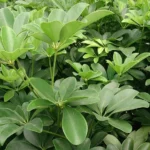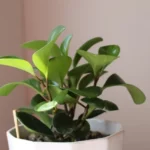Table of Contents
Everything You Should Know About the Paddle Plant
Are you looking for a plant that can add color and pomp to your home’s plant collection? Well, you may want to consider the paddle plant because of its beauty and ease of planting.
As long as the plant gets its needs, it will make your plant collection more appealing.
The paddle plant boasts fleshy, gray-green leaves that are round in shape. The leaves also have red tinges around tips.
So, how do you get started with propagating this plant?
How to Care For paddle plant
Paddle plants are among the low maintenance plant a homeowner can have in their plant collection. You can plant it in a light shade or full sun location.
The plant doesn’t respond well to overwatering and over-feeding. Put the plant indoors during cooler winter months since it has a low tolerance for cold.
Pruning your paddle plants once they bloom or in late spring will allow them to produce healthier branches. Always sanitize the pruning tools before using them to avoid contamination or spread of diseases.
Trim any wilted or damaged flower stems and brown/yellow infected leaves. When cutting wilted leaves or stems, sharply remove them from the plant’s base.
What does your paddle plant require?
Just like other succulents, paddle plants have minimal growth requirements. But that doesn’t mean that you should leave it unattended. For its sustainable and healthy growth, here are the requirements needed.
Light Requirements
You can grow the paddle plant indoors or outdoors, depending on your preferences. If you’re planting it indoors, choose a brightly-lit location. Ensure that sunlight doesn’t come through directly through your home’s glass window to avoid scorching the plant.
For outdoor planting, you can grow it in a partial shade or a spot with full sunlight. Always keep the plant shielded from intense rays during the summer.
Temperature Requirements
Paddle plants can withstand dry conditions except when it’s cold. Your home should be in an area with a USDA hardiness zone rating below ten. Grow the plant in a pot to help regulate the temperatures as soon as they get uncomfortably low.
Average room temperatures should range between 18 to 24 degrees Celsius (65 to 75 degrees Fahrenheit).
Soil Requirements
Keep the soil dry most of the time for your paddle plant to survive. If you’re using a soil mix, get one that quickly loses water to avoid waterlogging. Avoid using soggy soils since they’ll create a similar effect to overwatering.
A mixture comprising pumice (or perlite), coarse sand, and sand soil will work.
Humidity Requirements
Paddle plants require a 40 percent relative humidity for them to survive. The same humidity levels should apply to outdoor settings. Planting the paddle plant in your home will help increase humidity and oxygen supply.
How to Water
Go slow with the watering sessions since the plant doesn’t thrive in water-logged soils. Water it from the bottom of the pot only when the soil completely dries out.
Since paddle plants are usually dormant during the winter, you’ll have to cut back on watering significantly.
How to Fertilize
Paddle plants are drought tolerant and require minimal fertilizer to thrive. Fertilize your plant once after two months with a general-purpose fertilizer.
Summer and spring are ideal for fertilizing the soil. Use half-diluted fertilizer for easier absorption.
Extra tips for paddle plant
The paddle plant is an excellent addition to Mediterranean gardens, rock gardens, and coastal gardens.
You can also grow them on flower beds or containers. Either way, it’s important to follow certain care practices for the plant’s survival.
Pests & Diseases
Provided you maintain and water the plant, it won’t be prone to pests or diseases. However, excessive feeding and watering may cause root rot or attract powdery mildew.
Hideous insects such as plant scales, mites, and mealybugs may also attack the plant.
Pruning
Always use a sharp, sanitized knife to trim leaves from your paddle plant. Allow it to be callous for several days before pruning it. Use the knife to trim off tall stems that bloom or show signs of dying.
Propagation
You can propagate paddle plats using offsets, leaves cuttings, and stems cuttings. Inserting stem cuttings into the soil is the only way to make them grow, unlike the leaves cuttings and offsets.
Always use a sharp, sanitized knife (or scissors) to cut out offsets, leaves, and stems needed for propagation.
Give the cut parts two to four weeks to callous to prevent infections or rotting. Place the offsets and leaf cuttings on a well-draining mix to allow them to shoot. For stem cuttings, insert them deep into the mix.
Store the succulent in a brightly-lit spot far away from direct rays/light. The mix should always be moist. Plant the offsets and leaves once roots form. For the stem cuttings, allow the leaves to form before transplanting them.
Always use gloves when propagating the cuttings and offsets to avoid contamination. If you’re using bare hands, thoroughly wash them when handling the plant. You should also keep pets and kids away from the plant for it to thrive.
FAQ
Is a paddle plant a succulent?
Paddle plants have fleshy, thickened parts that qualify them as succulent plants. They also grow well in dry soils thanks to their ability to retain water.
You can grow them indoors to improve your home’s humidity, purify the air, and boost oxygen concentration in the air.
Why is my paddle plant dying?
At some point, your paddle plant will die once it loses its sweet-smelling blooms. Don’t panic when this situation happens.
Instead, cut away the dead part to allow the remaining stalk to shoot. You can then use the offsets to grow a new collection.
Are paddle plants toxic?
As part of the flapjack family, the paddle plant’s flowers, leaves, and roots are toxic. You should always keep your kids and pets from the plant.
Thoroughly wash your child’s hands when they touch the plant’s flowers to prevent them from suffering from diarrhea or vomiting.
Do paddle plants bloom?
Paddle plants tend to produce a cluster of flowers once they reach maturity, mostly in late winter to early spring. Since they are monocarpic, they die immediately after flowering. The flowers come out when the plant reaches a height of about 30 inches after 3 to 4 years.
How do you repot a paddle plant?
Use a pot with adequate space and heft to handle the plant’s weight. Loamy or sandy potting soil with good drainage will be ideal for repotting.
Well-drained soils prevent water from sucking and pooling away essential nutrients. Space the succulents at least 8 inches apart when transplanting them.
How do you care for a paddle plant?
Your paddle plant will respond to the type of care you give it. Keep the potting mix lightly moist and evenly but never soggy.
Expose the plant to indirect sunlight for it to thrive. Once it establishes itself, you can prune dead leaves and stems.
When should you repot a paddle plant?
Repot the plant when its roots are popping out of its drainage hole after every 12 to 24 months.
You can also repot it when it booms, begins to die back, or becomes too heavy or big for the pot. Frequent repotting will make the stems weak and wither the leaves.
How often do you water a paddle plant?
Water the paddle plant only when the soil shows signs of dryness. Allow up to 2 inches of the soil to completely dry out before watering it again. Soggy soil may cause rotting in the roots.
How do you prune a paddle plant?
Cut the dead or overgrown leaves and stems using a sharp, sterile knife. You can use the cut parts as mulch or dispose them off. Be careful not to cut healthy stems or leaves.
Photo by David J. Stang, CC BY-SA 4.0 https://creativecommons.org/licenses/by-sa/4.0, via Wikimedia Commons


